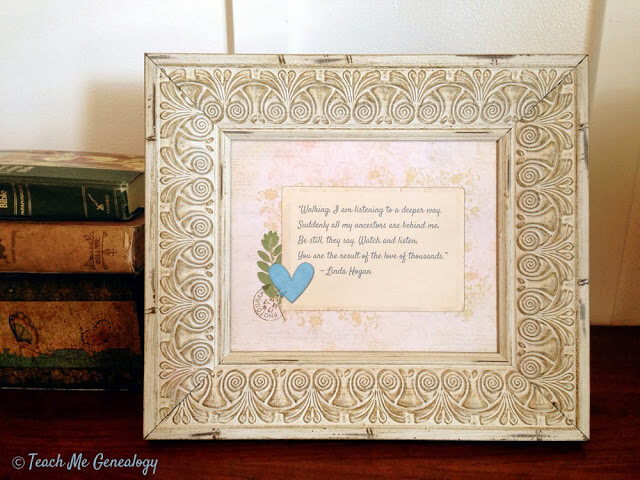Your Family will love learning about why Turkey's "Gobble-Gobble" and what Pilgrims ate during their first Thanksgiving Dinner with these Thanksgiving Fun Facts.
They are perfect for getting your whole family talking during Thanksgiving Dinner! Teach Me Genealogy has created 30 FREE Thanksgiving Fun Facts to use in your place settings or anywhere on the table.
2 Colors to Choose from (30 cards total on 5 pages)
Traditional Colors on left or Modern Colors on right
Click images to enlarge and get a closer look.
Click the image to download and print.
Okay, now for the fun part: Use a shower curtain ring to slip a
cloth napkin through
and magically it's a napkin ring. (12 for $1.29 at Walmart)

Here's how your new (very inexpensive) napkin ring looks. Now just tape
the
Fun Fact card to the ring.

Use masking tape or painters tape to adhere the Fun Fact card to the ring.
(masking tape won't rip the paper when you want to remove for storing)

Looks great doesn't it?
This place setting is sure to be an eye catcher that will leave your guest talking
for a long time :)

Another option is placing the cards in a cute jar and passing it around until everyone gets a turn
to read a Fun Fact card. Keep them stored away in this cute jar for the rest of the year.
30 Thanksgiving Fun Facts:
-
The Carbuncle is a brightly colored growth on the throat region. Turns bright red when the turkey is upset or during courtship.
-
Benjamin Franklin wanted the turkey to be the United States national bird instead of the bald eagle!
-
Abraham Lincoln issued a “Thanksgiving Proclamation” on October 3, 1863 and officially set aside the last Thursday of November as the national day for Thanksgiving.
-
Turkey makes you sleepy because
it contains L-tryptophan, an
essential amino acid with
a documented sleep inducing
effect.
-
Turkeys can run up to 20 miles
per hour. They can also fly at
speeds between 50-55 mph.
-
Female turkeys do not “gobble”.
So, the next time you hear a
“gobble - gobble” sound, you’ll
know it’s a male turkey, (a "Tom").
-
Turkeys ears are small holes in
the head located behind the
eyes. Their hearing can pinpoint
sounds from a mile away.
-
Turkeys eye position allows the
animal to see two objects at once,
but limits its depth perception.
Turkeys can gain a 360 degree
field of view.
-
The Wattle is the flap of skin
under the turkey's chin that
turns bright red when the
turkey is upset or during
courtship.
-
The Snood is the flap of skin
that hangs over the turkey's
beak that turns bright red
when the turkey is upset or
during courtship.
-
In the US, about 280 million
turkeys are sold for the
Thanksgiving celebrations.
Which is about 4 billion
pounds of turkey.
-
The annual Macy's Thanksgiving
Day Parade tradition began
in 1924 and featured floats,
clowns, bands and a few
zoo animals.
-
Californians are the largest
consumers of turkey in
the United States.
-
The Pilgrim leader, Governor
William Bradford, had organized
the first Thanksgiving feast in
1621. He invited the Wampanoag
Indians to the feast.
-
The Plymouth Pilgrims were
the first to celebrate
Thanksgiving.
-
The Pilgrims sailed across the
Atlantic Ocean to North
America on a ship called
the "Mayflower".
-
The Plymouth Pilgrims celebrated
the first Thanksgiving Day at
Plymouth, Massachusetts.
-
The Wampanoag Indians were
the people who taught the
Pilgrims how to cultivate
the land.
-
The first Thanksgiving
celebration lasted three days.
-
Mashed potatoes, pumpkin pies,
popcorn, milk, corn on the cob,
and cranberries were NOT
foods present on the first
Thanksgiving's feast table.
-
Lobster, rabbit, chicken, fish, squashes,
beans, chestnuts, hickory nuts, onions,
leeks, dried fruits, maple syrup and
honey, radishes, cabbage, carrots,
eggs, and goat cheese were most likely the foods eaten during the
first
Thanksgiving feast.
-
The average weight of a turkey
purchased at Thanksgiving
is 15 pounds.
-
The heaviest turkey ever raised
was 86 pounds.
-
A 15 pound turkey usually has
about 70 percent white meat
and 30 percent dark meat.
-
Turkey has more protein
than chicken or beef.
-
Turkeys make a “gobble-gobble”
sound and strut about shaking
their feathers, which helps the
male attract females
for mating.
-
Domestic or tame turkeys weigh
twice more than a wild turkey
does, and are raised on farms
for profit.
-
Most domestic turkeys are so
heavy they are unable to fly.
-
Male Turkeys are called “Toms”
or “Gobblers”. Female Turkeys are
called “Hens”. Baby Turkeys are
called “poults”.
-
Each spring male turkeys (Toms)
try to befriend as many females as
possible by puffing up their
bodies and spreading their
tail feathers.
Happy Thanksgiving 2012!!









































